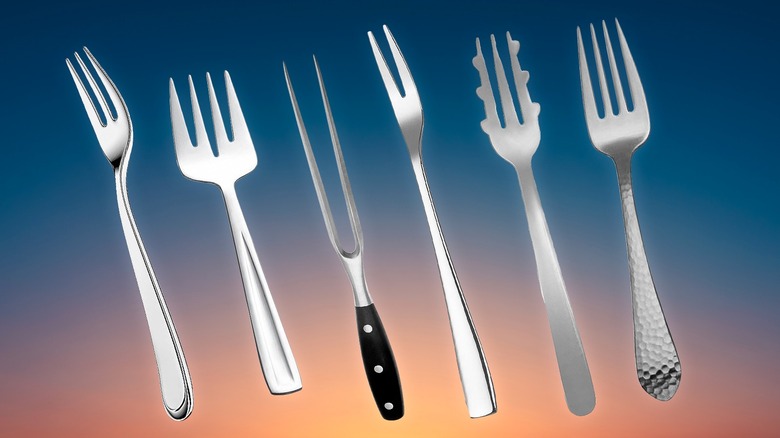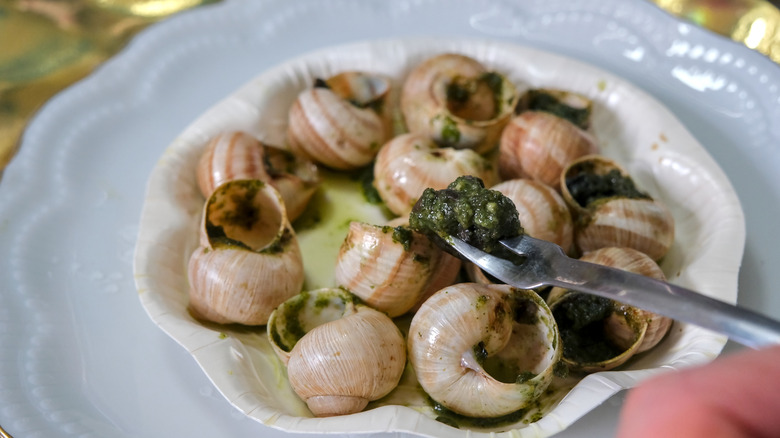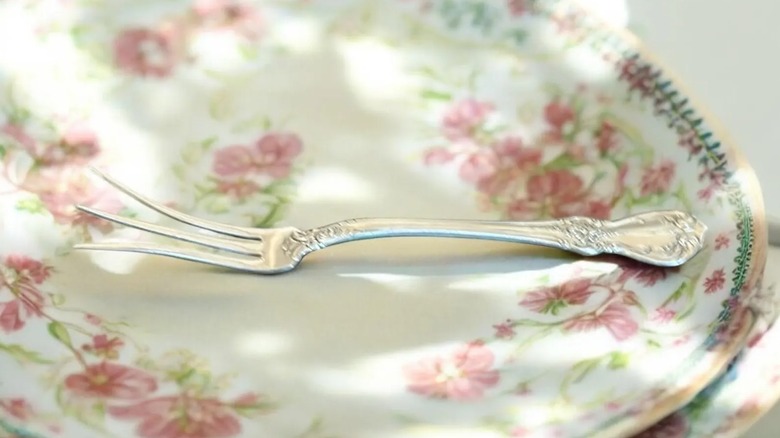The Ultimate Guide To Forks: When And Why To Use Each Type
We may receive a commission on purchases made from links.
Forks. We use them to eat a variety of foods, including salads, steaks, grilled veggies, and even cake. You probably know that there are different types of forks — you likely even have at least two or three different styles sitting in your silverware drawer right now. But, did you know that those few styles are far from the only types of forks out there? Just as there are many different types of spoons and countless types of knives, there are also several types of forks. Each of these forks has a unique design. Some have more tines, while others may have tines of different lengths or with more or less space between them.
Each type of fork was designed with a specific purpose in mind. Once you learn more about these different types of forks and when and how to use each type, you just might find a few new options you want to add to your table. For example, did you know that there is a fork specifically designed for eating spaghetti? Or one that was made for eating ice cream? Ahead, we'll take a close look at these fork types along with several others.
Dinner forks
When you're looking to create a simple yet elegant table setting, you might only want to include one or two types of forks. A dinner fork is certainly one that should make the cut. This is the fork type that you're probably most familiar with; with a formal place setting, you'll find the dinner fork to the left of the salad fork, which is to the left of the plate.
While a dinner fork may be your go-to when dining at home, this utensil hasn't been around for as long as you might guess. They were first designed towards the beginning of the 19th century, around the same time that more of an emphasis was being placed on formal dining. Dinner forks are among the longest forks, and certainly the longs you'll find on a formally set table. They are typically between 7 and 8 inches long and have four tines. As you probably already know (or can guess based on the name), these forks are meant to be used when eating a main course.
Salad forks
Some people see salad forks, which go directly to the left of the plate with a formal table setting, as interchangeable with the dinner fork. However, while you may use your salad fork to eat a main course, that was not what this style was developed for. As the name implies, they were specifically designed to be used when eating salad.
Compared to a dinner fork, salad forks have a wider head. Their tines are also not quite as long. With this design, they are better suited to picking up salad and holding more of the thin dressing to help it reach your mouth instead of simply sliding back onto the plate. The handle of a salad fork is about 1-2 inches shorter than that of a dinner fork, which can also help you distinguish these two commonly used utensils.
Dessert forks
One quick look at a dessert fork and it should be clear that they are designed to be used with more delicate items. These forks are smaller than many of the other ones you'll find in a formal setting. They also typically have three tines, compared to the four tines of many of the other forks at the table.
The smaller design of a dessert fork, which you might also see called a pastry fork, makes it ideal for use with softer and more delicate treats, such as cakes or tarts. If you look closely at a dessert fork, you may notice one other unique feature — one of the end tines is wider than the rest. This design is very intentional and makes it easier for users to cut through slightly thicker pastries using the side of the fork (even when standing and eating, as one may be doing during an afternoon tea or when at a party).
Serving forks
Serving forks are designed for precisely what they sound like: serving food. They are much larger than a standard fork. Depending on the model, they may have three or four tines.
Regardless of the number of tines, they will typically be wider than those found on other forks. These wider tines help the forks hold heavier food items, such as sliced meat, to ensure a smooth transfer from a serving platter or carving board to a guest's dinner plate.
Cocktail forks
Cocktails forks, which you may also hear referred to as cocktail picks, are a very small utensil. They have a short handle and, depending on the specific set, may have either two or three tines.
As you may guess based on their name, they are typically used to eat (or pass out) smaller hors d'oeuvres. Because of their smaller size, they are ideal for eating smaller appetizers, such as olives, fruit, or shrimp.
Oyster forks
You probably won't be surprised to find out that oyster forks were designed to be used when eating oysters. Because of this intended purpose, these forks are much smaller than many others that you'll find in a formal place setting. Oyster forks have three tines that are on the sharper side since they are designed to help pull the oyster meat off of the shell. They're also slightly curved to help you slide them in under the meat and pull it out without it sliding off.
If you look at a formal place setting, you may be surprised by where the oyster fork is located. It is the last utensil to the right of the plate, next to the soup spoon. It is also the only fork that you'll find on the right side, with the salad fork, dinner fork, and fish fork being to the left and the dessert fork above the plate. The reason that the oyster fork is the only fork to the right of the plate is that it does not have a knife or shell cracker that pairs with it, unlike the three knives to the left of the plate.
Fruit forks
If you're like many, you probably just grab any ol' fork out of the drawer if you want to eat some sliced melon or a fruit salad. However, there actually is a utensil specifically designed for this purpose: the fruit fork.
Fruit forks are smaller than most salad forks, measuring between 5 and 6 inches long. They typically have three tines, but some may have four. With true formal dining, you'd also have a fruit spoon and fruit knife to use alongside the fruit fork for enjoying various fruit appetizers and other items.
Fish forks
If you guessed that a fish fork was meant for eating fish, then you're right. They may have three or four tines and often feature a small notch on one side to complement the look of the fish knife that they are paired with.
Because they are designed for eating fish, these forks tend to have a wider and gently curved head. The curve and the extra width makes it easier to flake pieces of fish off more precisely instead of breaking bigger chunks off.
Ice cream forks
Chances are, you've never used — or likely even heard of — an ice cream fork before. Believe it or not, however, these are indeed a real thing. During the Victorian era, when there was much focus on formal dining and all the "necessary" utensils to go with it, someone had the brilliant idea of making a fork designed just for ice cream. Because, why would you use a spoon for something so soft and melty?
Ice cream forks resemble today's sporks, but the ratio of the "spoon" to the "fork" is much greater. The tines on these forks are very short. If you're trying to eat ice cream off of a plate, as opposed to out of a bowl, you may actually find that you appreciate that little extra piercing power.
Cheese forks
If you're always searching for the best ideas to build a charcuterie board for all of your entertaining needs, then you might be interested in learning more about cheese forks. These forks have a relatively stubby appearance. They have a short handle with two proportionally longer tines.
The longer tines are designed to help keep a block of cheese from sliding around as you cut it with a cheese knife. In addition to holding hard cheeses when slicing them, cheese forks can also be used with softer cheeses, such as blue cheese or feta cheese. You can use the longer tines to break a few crumbles off a larger chunk before putting them on your plate.
Deli fork
If you've ever tried to pull a slice of prosciutto or ham off of a charcuterie board or antipasto platter only to have the meat tear, then you probably could have benefited from having a deli fork available. Also called prosciutto forks, these utensils were designed to help pick up thin slices of deli meats.
As you may be able to guess based on the fact that they are designed to be used with delicate meats, deli forks are much smaller than many other utensils. Most have just two tines to allow you to carefully pick up meats from the deli without damaging them.
Carving fork
Unless you want to make a mistake with roast beef, turkey, or a London broil, you'll want to make sure that you have a carving fork handy when you're ready to slice the meat. Without a carving fork, you're likely to end up with uneven slices. And, possibly even worse than that, your roast may end up sliding and shifting all around as you try to cut it.
To help hold those large cuts of meat in place, carving forks offer two long prongs. While some carving forks have straight tines, many feature curved tines. This design helps ensure that the tines are away from where you're slicing, ensuring you'll be able to cut through the meat without hitting them with the knife.
Spaghetti fork
If you enjoy pasta on a regular basis and are always searching for the best recipes to upgrade spaghetti night, then you might start wondering why you've never heard of a spaghetti fork before. Just as the name implies, these utensils are designed specifically for eating spaghetti.
With a spaghetti fork, you can say so long to the frustration of having all the long noodles slide off of your fork after you've twirled them around it. These special forks have several little bumps or nodes along both sides of the outer tines. These little nodes help secure the pasta as you twirl it around the fork — no help from a spoon necessary!
Crab fork
Have you ever eaten crab legs before and grown frustrated when a nice piece of meat gets stuck inside the shell? It always works out that the crab meat is too deep within the long legs for the tines of a regular fork to help you pull it out, does it?
This is the precise reason crab forks were designed. They have a very long and slender handle with two (or sometimes three) tines at the end. Because of their slim design, they can slide into a crab shell to help you carefully extract the meat. Crab forks can also be used when eating other types of shellfish, such as lobster, as well.
Snail fork
If you're planning a formal dinner party and planning to serve escargot, then you might want to have some snail forks available for your guests. These forks have two long tines and a relatively short handle.
Also called an escargot fork, a snail fork can be used when removing a prepared snail from its shell or one from a special snail dish. You'll often see snail forks used alongside snail tongs. The tongs help keep the shell from sliding around as you extract the meat using the fork.
Baked potato fork
If you've ever tried to serve baked potatoes, then you know how awkward it can be. You don't want to lift the potatoes with your fingers to your guests' plate. However, a standard fork can't always support the weight, and if it does, the potato often gets stuck on the fork, and you're left to have to push it off with your fingers anyway.
Enter the baked potato fork. Designed specifically to pick up baked potatoes and serve them, these forks are around the same size as other serving forks. The design of the tines can vary, though. Some feature two wider and slightly curved tines to help pick up a potato and guide it to a plate. Others have a much more unique appearance, featuring four widely spaced out and splayed tines.
Toasting fork
Many years ago, toasters, let alone some of the impressive smart toasters we have today, weren't even on the radar. Instead, if someone wanted a piece of toast, they had to hold a slice of bread over a fire until it turned brown and crispy.
To keep the user's hands away from the fire, toasting forks had a very long handle. They were often made from brass, but some were also constructed from iron. The forks have three long and skinny tines to help hold a more delicate slice of bread and prevent it from dropping into the flames. Their design looks quite similar to a pitchfork.
Lemon fork
As you can probably guess, a lemon fork is used to serve lemon wedges and, often, other garnishes. These forks have a handle that is about the same length as that of a salad fork. They also have three tines.
However, what makes a lemon fork unique is the design of its tines. Instead of being straight like those of most other forks, the two outer tines curve out towards the sides. This design enables these forks to more easily pick up and hold on to a lemon wedge.
Pickle fork
While you may use your fingers to pull a pickle out of a jar, doing so isn't proper etiquette and certainly wouldn't be considered so in a more formal setting. Instead, you should use a fork to extract the pickle from the jar.
However, not just any fork will do. Pickle jars are deep, and reaching in with a standard fork can be tricky. Pickle forks are designed for this precise use. They feature a long handle (up to 8 inches) and may have between two and three tines. Pickle forks are also very slim, making it easier to slide them into a tight jar.



















